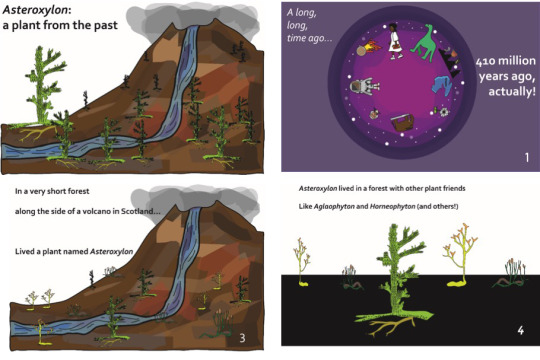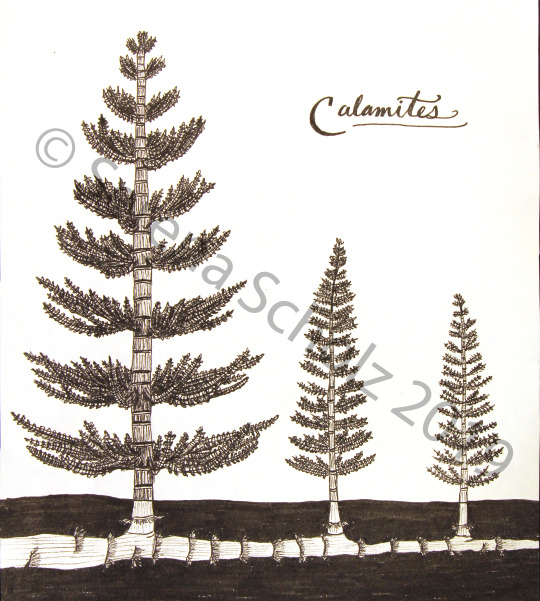Text
Plant Paleobiology term projects, part 2
Here are two more class projects -- these were voted #2 and #3 favorites in the class.
First, Rebekah Stein’s work is based on a specimen of Asteroxylon. Here’s what she wrote about it:
Asteroxylon was a lycophyte found in the lower Devonian Rhynie Chert, a chert formation in northeast Scotland by volcanic activity and a subsequent ancient hotspring, permineralizing rich terrestrial and freshwater flora in place, ~400 million years ago (Devonian; Hueber 1992; Taylor et al. 1997). Of the flora within this chert, Asteroxylon is one of the better studied plants, though has no extant specimens and has long been extinct. Typically, this early vascular plant had isotomously and anisotomously branching stems with G-type tracheids (like many early lycopsids). Asteroxylon was very distinct in that it has an actinostele-typed protostele, or star-shaped stele, with exarch xylem; protoxylem is towards the end of the lobes and phloem develops between the lobes. Asteroxylon did not yet have leaves, instead it had leaf-like appendages called enations emerging from the epidermis (without xylem entering the base), spiral around the stem. The vascular bundles extended from the centralized actinostele toward the enations but not into the enations, which is what distinguished them from leaves (Kerp et al. 2013). At the end of the axes, the sporangia were kidney shaped, flattened medially (Lyon 1964). The axes and enations above ground both had cuticles with stomata. Asteroxylon existed before the advent of true roots, and instead had rhizomes. These rhizomes lacked rhizoids and branch repeatedly, with specialized off-shoots that displayed positive gravitropism to stabilize.
As the Rhynie Chert is such a phenomenal example of a paleoecological system rife with niches, it is important to note Asteroxylon’s interaction with surrounding organisms. Rather than being found in an Asteroxylon-dominated niche, Asteroxylon was typically found in a diverse setting mixed with genera like Nothia, Rhynia, Aglaophyton and Ventarura (Trewin 1993). Asteroxylon was, however, better at tolerating dry habitats due to its complex vascular system, compared to other members of the Rhynie Chert (based on larger photosynthetic surfaces on enations, as well as an extensive root system), and therefore was likely more competitive upland (Kerp et al. 2013).
My illustration
For my overall specimen drawing, I chose to draw the unique and distinctive actinostele of the Asteroxylon, emphasizing the stellate xylem. In my drawing, which is a transverse cross-section through the aerial axis of Asteroxylon, the protostele with its exarch star-shaped xylem is obvious. In addition to showing this stele, leaf traces from where the enations form are abundant.

Recently, I have been very focused on the fact that earth sciences are poorly represented in the primary and secondary school curriculum, which has resulted in a lack of interest (based largely in not knowing) in earth and geosciences until late in graduate school. However, earth sciences influence all of our lives, and studying this “subject” is the curricular version of studying the earth around us. In order to increase interest in earth sciences at a college level, it is important to make them accessible at a young age. Therefore, I wanted to make a book for primary school aged children about fossils, in the hopes that it piques the interest of readers and informs them of possible career, research, and study directions in the future.
Because of the audience, the language used to describe my specimen is very simplified. I did include a few words that would normally be considered jargon, but I felt were integral to describing Asteroxylon correctly (rhizomes, enations, actinostele). I emphasized these words in text and treated them as new “vocabulary” words. I imagine the target audience is ~6 years old, but do not consider myself an expert in reading levels.
I aimed to make this subject matter approachable by acting as if members of the audience were in fact an inspiring paleobotanist themselves. Therefore, I drew children scientists, made the setting very vivid, and cartoonized Asteroxylon.

References:
1. Hueber, Francis M. "Thoughts on the early lycopsids and zosterophylls." Annals of the Missouri Botanical Garden(1992): 474-499.
2. Taylor, T. N., Klavins, S. D., Krings, M., Taylor, E. L., Kerp, H., & Hass, H. (2003). Fungi from the Rhynie chert: a view from the dark side. Earth and Environmental Science Transactions of the Royal Society of Edinburgh, 94(4), 457-473.
3. Kerp, H., Wellman, C. H., Krings, M., Kearney, P., & Hass, H. (2013). Reproductive organs and in situ spores of Asteroxylon mackiei Kidston & Lang, the most complex plant from the Lower Devonian Rhynie Chert. International Journal of Plant Sciences, 174(3), 293-308.
4. Lyon, A. G. (1964). Probable fertile region of Asteroxylon mackiei K. and L. Nature, 203(4949), 1082.
5. Trewin, N. H. (1993). Depositional environment and preservation of biota in the Lower Devonian hot-springs of Rhynie, Aberdeenshire, Scotland. Earth and Environmental Science Transactions of the Royal Society of Edinburgh, 84(3-4), 433-442.
The other project I’ll feature today is by Serena Scholz, who based her project on Annularia. Here’s her work:
General overview:
Annularia is the form genus of the leaves of Calamites, an extinct tree-like plant that belongs to the same evolutionary lineage as modern horsetails. Unlike living horsetails, which are in the genus Equisetum and are small and herbaceous, Calamites were medium-sized trees, growing to heights of over 30 meters. The leaves (Annularia) are arranged in whorls around a central stalk, with anywhere from 8-13 leaves per whorl. Branches also grow in a whorled pattern, often from an internode or a node of the segmented central stem. The stem is usually hollow, with secondary xylem providing a rigid outer structure around the outside, which has led to many interior casts of broken stems being preserved in the fossil record.
Annularia first appears in the fossil record in the early Carboniferous, and disappears by the mid Permian. This particular specimen is a compression fossil from the Carboniferous. Arborescent horsetails (sphenophytes) are one of the four major groups that made up the Carboniferous coal swamps (360-300 Ma). The Calamites trees favored frequently disturbed habitats such as riverbanks, deltas, and lakeshores, due to their ability to asexually reproduce through underground rhizomes (Scott, 1979). This clonal reproduction allowed it to quickly colonize bare substrate, and also quickly regenerate after burial by alluvium (Gastaldo, 1992).

Adaptations for disturbed environments:
Niche partitioning between different major plant groups is clearly apparent in the fossil record of Carboniferous coal swamps. While the wettest parts of the swamps (the mires) were inhabited by arborescent lycopsids like Lepidodendron, arborescent horsetails like Calamites lived closer to the edges of the ecosystem, favoring frequently disturbed, aggradational areas with high rates of sediment influx (Bashforth et al., 2014). This is primarily due to the biological adaptations of the plants to different ecological niches: lycopsids had evolved shallow, hollow rootlets (Stigmaria) which enabled them to aerate their roots within the otherwise waterlogged soils of the mires. In contrast, one of the most important biological features of Calamites was its system of woody, underground rhizomes, which allowed it to regrow after flooding and burial, and also promoted clonal reproduction in order to quickly colonize bare substrate (Gastaldo, 1992). The rhizomes are large and woody, and look very similar to the segmented stems, though the nodes get increasingly close together as they approach the apical area.
These rhizomes made Calamites extremely tolerant of long-duration flooding and partial burial by alluvium, as they allowed the plants to immediately regenerate from the rhizome after flood events occurred, as opposed to waiting for the sexual reproductive cycle to grow new colonies. They also provided stability and anchorage in unstable ground such as newly-deposited, unconsolidated sediments. These horsetails were therefore dominant in areas with high potential for flooding or burial by sediment, including riverbanks, lakeshores, and deltas (Scott, 1979), as well as clastic floodplains (Martín-Closas and Galtier, 2005). While they do possess sexual means of reproduction as well (Calamites is free-sporing with sporangia borne on cones), these asexual methods were much more prevalent and important to their ecological niche (Gastaldo, 1992).
A recent study of modern herbaceous horsetails (genus Equisetum), showed that the plants have a significant convective ventilation ability, also known as humidity-induced convective aeration (Armstrong and Armstrong, 2009). The Equisetum genus is one of very few non-angiosperm plants to have such a high convective flow, which was found to be primarily used for aerating the underground rhizomes still present in modern species. The authors of this study proposed that Calamites and other fossils in the Equisetaceae family may have also had this convective ability as well, due to the close anatomical and morphological similarities between the living and extinct species. If true, this could indicate that plant ventilation via a molecular gas pump may have existed since as early as the Carboniferous or early Permian, much earlier than previously believed. This ability to aerate the underground rhizomes may also have played a key role in allowing the fast regeneration and clonal growth of Calamites after flooding or burial events.

References:
Armstrong, J., and W. Armstrong. 2009. Record rates of pressurized gas-flow in the great horsetail, Equisetum telmateia. Were Carboniferous Calamites similarly aerated? New Phytologist 184: 202–215.
Bashforth, A. R., C. J. Cleal, M. R. Gibling, H. J. Falcon-Lang, and R. F. Miller. 2014. Paleoecology of Early Pennsylvanian vegetation on a seasonally dry tropical landscape (Tynemouth Creek Formation, New Brunswick, Canada). Review of Palaeobotany and Palynology 200: 229–263.
Gastaldo, R.A. 1992. Regenerative growth in fossil horsetails following burial by alluvium. A Historical Biology 6: 203-219
Martín-Closas, C., and J. Galtier. 2005. Plant taphonomy and paleoecology of Late Pennsylvanian intramontane wetlands in the Graissessac-Lodève basin (Languedoc, France). PALAIOS 20: 249–265.
Scott, A.C. 1979. The ecology of Coal Measure floras from northern Britain. Proceedings of the Geologists Association 90: 97–116.
0 notes
Quote
The true meaning of life is to plant trees, under whose shade you do not expect to sit. - Nelson Henderson
0 notes
Text
Gaga about taxonomy
Somehow, taxonomists have a reputation of doing "boring" science. Even the word sounds boring. Who wants to spend all day looking at plant bits and deciding if these are the same or different? Are they same or different enough to be classified in the same species, genus, family? And yet, it's such a fundamental part of biology. We need to know what organisms are before we can usefully start discussing them, investigating their ecology, how they evolved, etc. How can we communicate effectively without scientific names? A cattail to one person is not the same as a cattail to another. Taxonomy is not boring. And with DNA sequencing, it has become much more intimately linked with evolution.
So, it's fun to see examples where taxonomy is doing important work, adding to our knowledge of biodiversity and evolution, but also how it can be linked to social and cultural topics of the day. Case in point: a new genus of ferns named Gaga after Lady Gaga. That's kinda cool. Apparently it's due to both a unique g-a-g-a sequence in their DNA separating them from other ferns, but also because of some of the morphological resemblances between these ferns and some of her costumes. As a supporter of individuality and positive role-model, she's not a bad choice to name a genus after!
Story here: http://www.eurekalert.org/pub_releases/2012-10/du-nso102312.php
0 notes
Quote
What is a weed? A plant whose virtues have not yet been discovered.
Ralph Waldo Emerson
0 notes
Text
Ancient Hawaiian moss
This is a pretty cool article about a sphagnum moss in Hawaii that researchers think is descended from one plant that was blown to the island on wind many thousands of years ago,
What has that moss seen? I bet it has stories to tell. It's pretty amazing to think of how long some species have existed. Like the sensitive fern, Onoclea sensibilis: we have fossils from Alberta that date back to the Paleocene, making that species over 50,000 years old.
0 notes